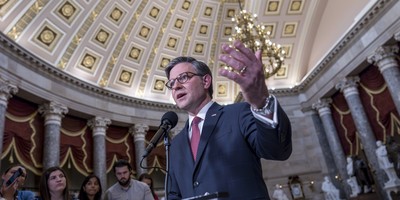On the last day of July, with a Republican-controlled House of Representatives serving as co-pilot, President Barack Obama flew the United States past a dubious fiscal landmark on our way toward what increasingly looks like a crash landing.
That day, the federal debt hit $17,687,136,723,410.59 -- an increase of roughly $7 trillion since Obama took office on Jan. 20, 2009.
That $17,687,136,723,410.59 in debt works out to approximately $171,575 for each of the 103,087,000 full-time year-round workers the Census Bureau says were in the United States as of 2012.
And that counts the 16,606,000 full-time year-round workers who took their paychecks from the government -- rather than working for themselves or for private organizations.
The $7,060,259,674,497.51 that Obama helped add to the federal debt between his first inauguration and the last day of July works out to about $68,488 for each full-time year-round worker in the country as of 2012.
How many of those full-time workers have borrowed an additional $68,488 in their own names since Obama took office -- unless it was to take out a mortgage on a house they are now already paying down?
Obama has offered no plan for paying down the federal debt -- let alone for bringing the federal budget into balance.
Shortly before the new debt under Obama passed the $7 trillion mark, the Congressional Budget Office released its latest long-term budget outlook.
It describes our flight path toward disaster.
Recommended
If current laws are not changed, 25 years from now (in 2039) the federal government will spend 6.3 percent of the gross domestic product on Social Security alone, the CBO estimated. That same year, it will spend 4.6 percent of GDP on Medicare, 3.4 percent on Medicaid, the Children's Health Insurance Program and Obamacare subsidies, and 4.7 percent on net interest on the federal debt.
Together, federal spending on just Social Security, the major health programs (Medicare, Medicaid, Chips and Obamacare), and interest on the debt will equal 19 percent of GDP, the CBO estimates.
That is before the federal government spends a penny on food stamps, public housing, the Department of Education or the Environmental Protection Agency.
It is also before the federal government spends a penny on national defense or the State Department, which carry out its core constitutional responsibilities.
And it is before the federal government spends a penny to staff and maintain the judiciary and legislative branches.
When you add the 6.4 percent of GDP in deficit spending that the CBO estimates the federal government will undertake in 2039 to the 19 percent the federal government will spend solely on Social Security, federal health programs and interest on existing debt, that equals 25.4 percent of GDP.
Similarly, when you add up all federal spending that the CBO estimates will take place in 2039 it equals 25.9 percent of GDP.
The White House Office of Management and Budget maintains an historical table that lists federal tax revenues and spending as percentages of GDP for each year from 1930 through 2013. It shows that in that 84-year span there was only one year when revenue went as high as 20 percent of GDP. That was 1944 -- at the height of World War II.
In 1943, 1944 and 1945, during the war, federal spending ran at 42.6 percent, 42.7 percent and 41.0 percent of GDP. Since then, it has never exceeded 25 percent -- and has averaged 19.3 percent.
For the federal government to balance the budget at 25 percent of GDP, it would require a sustained level of federal taxation unprecedented in American history. For the federal government to maintain the current welfare state without balancing the budget would require accumulating levels of debt unprecedented in American history.
"With deficits as big as the ones that CBO projects, federal debt would be growing faster than GDP, a path that would ultimately be unsustainable," said the CBO outlook.
"How long the nation could sustain such growth in federal debt is impossible to predict with any confidence," said the CBO. "At some point, investors would begin to doubt the government's willingness or ability to pay its debt obligations, which would require the government to pay much higher interests costs to borrow money."
"If a fiscal crisis were to occur in the United States, policymakers would have only limited -- and unattractive -- options for responding," said the CBO. "In particular government would need to undertake some combination of three approaches: restructure the debt (that is, seek to modify the contractual terms of existing obligations), pursue an inflationary monetary policy, and adopt an austerity program of spending cuts and tax increases."
We need to cut the welfare state now, not after a crash.

























Join the conversation as a VIP Member